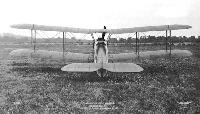
Описание
Страна: Великобритания
Год: 1920
H.King Sopwith Aircraft 1912-1920 (Putnam)
Grasshopper
If the Grasshopper as first appearances suggested was the case was Sopwith's answer to the Avro 504K, then (as C. G. Grey might have put it) Sopwith were simply saying 'Yes'. If - on the other hand - the machine is passed off as a modernised landplane development of the similarly powered prewar Anzani Tractor Seaplane then the answer must be 'No’. But in any case, neither answer would suffice, for the story (though concerning only a single aeroplane - G-EAIN) may well be more complex than the superficial facts suggest.
By Sopwith themselves this aeroplane was little publicised; and though its first C of A was not issued until 22 March, 1920 (the airframe having been built during 1919) the Grasshopper was clearly not regarded - as was the Dove as a type to be "pushed" in the postwar civil market. Yet, like so many other Cinderellas and Ugly Ducklings, it had its points of interest. Very apparent among these was its extremely low full-load landing speed of 35 mph (56 km h); indeed, its suitability for small-field operation, equally with its physical appearance, may well have suggested its whimsical name - likewise the description "tourer" which the makers themselves applied.
That for several years the Grasshopper enjoyed a continuing, if solitary, popularity is attested by its successive registrations, thus: Sold December 1922 to L. C. G. M. Le Champion; May 1923 to E. A. D. Eldridge; February 1925 to John Cobb; August 1925 to Dudley Watt ('Dangerous Dan', who rebuilt it); and February 1928 to Miss C. R. Leathart. On expiry at the end of May 1929, the last C of A was not renewed, though by that time the green-painted Grasshopper had afforded many people much joy - not least when flown round Brooklands motor-racing track (by J. King in 1926) with vastly more clearance between its top wings and the Byfleet bridge than between its wheels and the concrete.
Clearly, this aeroplane was a gentle, if inelegant, creation; and its character having stemmed largely from the fitting of a radial engine (100 hp ten-cylinder air-cooled Anzani) as distinct from the rotaries which generally powered the comparable Avro 504K family – and, for that matter, Sopwiths' own delightful Dove it seems worth considering the implications of this radial engine in the post-war private-owner market.
First must come the historical background for the pre-1914 Anzanis were already truly historic (Bleriot's 1909 cross-Channel effort being only one example of their use) and were technically very advanced. Rotaries, true, were the engines which, from 1908 onwards, enabled aviation to make the strides it did; and in the 1914-18 war especially their virtues of simplicity, lightness and compactness (not to mention availability) advanced their massive prestige. Yet once the war was over, prospective aircraft-owners many of whom had been wartime pilots much desired to leave behind them the concomitant associations of high consumption figures (both in petrol and oil), the inevitable gyroscopic effect produced by an entire engine that spun together with the propeller - and an inseparable grimy, clammy feeling of slung oil.
That the fixed-cylinder radial air-cooled engine was established in British service before the 1914 war is a fact too little recognized; and the Anzani was here preeminent. Companies which tried this engine in small aeroplanes included Blackburn, Handley Page, Vickers and Wight; and even in Felixstowe flying-boats and the towering Supermarine Nighthawk Anzanis were seen. Additionally there were the curious French Caudrons, which, with Anzani engines, served Britain well, especially for training (and which, to some extent, the Sopwith Grasshopper may originally have been intended to succeed).
On the debit side for the 100 hp Anzani were its ten cylinders - double the number eventually adopted for radial rivals to the inter-war Cirrus and Gipsy ranges. Heeded, too, must be Maj F. M. Green, that leading authority on engines in general and radials in particular, who said of 'post-Bleriot' engines: 'The engine [Bleriot's famous ‘fan'-type] was very soon followed by a large number of true radial engines made by the same firm, and others designed by Viale, who had formerly been connected with the Anzani firm. These engines were not, on the whole, successful, partly, I think, on account of a number of special difficulties connected with radial engines which had not then been solved, and also on account of the comparatively poor design of the cylinders.’
Nevertheless, in the postwar light-aircraft field the Sopwith Grasshopper helped to stake a very firm claim indeed for the radial engine - jointly, it may be added, with an Anzani-powered London and Provincial biplane, live examples of which came on to the British Civil Register.
As for the Grasshopper's airframe, there is little to add to what the pictures and the table tell, except to affirm that its structure was of wood.
Grasshopper (100 hp Anzani)
Span 33 ft 1 in (10 m); length 23 ft 1 in (7 m). Maximum weight 1,670 lb (757 kg). Maximum speed 90 mph (145 km/h).
Описание:
- H.King Sopwith Aircraft 1912-1920 (Putnam)
- A.Jackson British Civil Aircraft since 1919 vol.3 (Putnam)
Фотографии
-
H.King - Sopwith Aircraft 1912-1920 /Putnam/
Probably the finest picture of the Grasshopper ever taken - an uncaptioned Sopwith study evidently made on the same occasion as the dead-rear view that follows, with provision on the aircraft for civil markings not as yet applied. Note the staggered cylinders of the Anzani engine.
-
H.King - Sopwith Aircraft 1912-1920 /Putnam/
The Sopwith caption to this flattering study of the Grasshopper reads: 'S.1043 - Grasshopper No.1. - 100 hp Anzani - July 31/1919'. The 'No.1' appears to have been superfluous, as only one example is known.
-
A.Jackson - British Civil Aircraft since 1919 vol.3 /Putnam/
Sopwith Grasshopper



